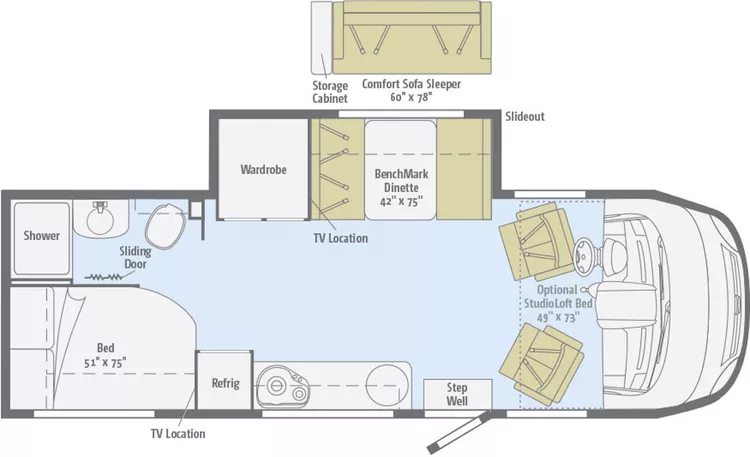Summary of the Winnebago Via 25Q Review
Basic Information
This review stems from a week-long test drive of a 2013 Winnebago Via 25Q. This new model had fewer than 1,000 miles at the time of my drive, and had a sticker price of approximately $139,000. A more recent model retails for $161,869, and might have slightly different specs than the vehicle for this test drive.
This Class A motor coach is 25.5 ft. in length, with a clearance of 11 ft. This model also has a driver’s side door that made frequent stops on scenic roads much more convenient.
The test drive followed a 1,350-mile route that began just north of Denver and ended in Las Vegas, with much of the route featuring mountainous terrain.
This RV is loaded with accessories, including an Infotainment Center GPS with voice navigation, Bluetooth capability, cruise control, and a rear-view camera. There are two flat-screen satellite TVs aboard, a stereo system with CD/DVD player, and two power air vents in the kitchen and bathroom areas.
The kitchen has a combination microwave/convection oven, and the refrigerator has a removable freezer unit. There is a two-burner propane stove. The bedroom has an RV queen-sized bed and the bathroom includes a small shower.
Liquid propane powers the 3,200-watt generator (used in places without an electric hookup).
Outside, a power awning extends out to a maximum of 16 ft. The gasoline tank holds 26 gal. of fuel; the sewage and gray-water tanks each hold 36 gal.
Driving and Parking
Most drivers may initially find it daunting to maneuver a 25-foot vehicle. However, I quickly adjusted to driving the Via, which corners extremely well, allowing ease in tight parking lots and fueling spaces.
Acceleration might be the larger adjustment for inexperienced drivers, as the Via takes longer to reach highway speeds and requires more patience on steep grades than standard automobiles. Fortunately, the Mercedes turbo-diesel engine provides more than adequate power for this vehicle.
A special driver’s license is not required to drive a Via, and it is equipped with an automatic transmission.
Cameras on the left, right, and rear provide added safety and convenience. The turn signal automatically activates the appropriate side camera, addressing potential blind spots, while the camera picture is easily viewed on the dashboard.
A note on the parking brake: it must be activated before slide-out sections can move. Our test model had minor electrical deficiencies related to the parking brake’s alarm system. A call to the manufacturer revealed that wiring under the driver’s seat can become bundled too tightly, potentially triggering false alarms.
Features
Winnebago builds the coach on a Mercedes Sprinter chassis and utilizes a 3.0-liter V-6 turbo-diesel engine.
Despite the challenging steep mountain grades during our test drive, the Via averaged approximately 12 miles per gallon over the seven days. Although such mileage might not impress budget travelers accustomed to smaller cars, it offers superior fuel efficiency for a Class A RV.
The dining area adjacent to the galley and bedroom extends outward about two feet once parked for the night. This additional space significantly enhances comfort in close quarters, especially for families.
The driver and passenger chairs swivel to create a living room atmosphere in the evenings, complete with a curtain that pulls across the windshield for added privacy. The coach boasts 6.5 ft. from floor to ceiling.
The Via is equipped with a roof-mounted air conditioner and a 20,000 BTU low-profile furnace, catering to climate needs effectively.
Kitchen
During our experience, starting the propane stove proved somewhat challenging, which may stem from the newness of the model. Cookware should typically be small and easy to store within an RV.
The refrigerator accommodates food for several days, and the microwave serves as a great convenience after long days on the road. However, we did not use the convection oven.
Considering the limited space for washing dishes, utilizing disposable plates and utensils is advisable. Notably, the Via offers more kitchen storage space than expected for its size.
Bedroom and Bathroom
The bedroom features an RV queen-sized bed (slightly smaller than a standard queen) and a seating area that can convert into an additional bed.
Compact bathrooms are standard in RVs, and the Via includes a water heating system that activates shortly before use. In our experience, it efficiently provided hot water—eliminating the risk of cold showers.
The holding tank is adequately sized at 36 gal., minimizing the need for daily emptying. However, keeping both this and the gray-water tanks under half-full is advisable due to the weight of the water. The gray-water system efficiently moves waste through a pump to the outflow pipe, and there’s a convenient freshwater nozzle for cleanup.
The Via holds approximately 34 gal. of fresh water, with an easily accessible fill-up entry point located at eye-level on the left-rear side of the vehicle.
Conclusions
The Winnebago Via delivers the convenience of a smaller RV while providing the storage capacity and living space usually found only in larger models.
Fuel expenses pose a significant challenge to RV travel; during our 1,350-mile journey, we spent $421 on diesel, which could have doubled in a less fuel-efficient model.
While the Via is equipped with numerous advanced features and technologies, first-time users may initially find the operations complex. It took me several days to fully familiarize myself with the functions, even after a comprehensive orientation session. A practical tip: record any dealer or rental agency introductions to refer back to later.
With an MSRP nearing $140,000, the Winnebago Via represents a serious financial commitment for prospective buyers; nevertheless, the comfort, convenience, and performance it offers warrant serious consideration for those exploring RV travel.




